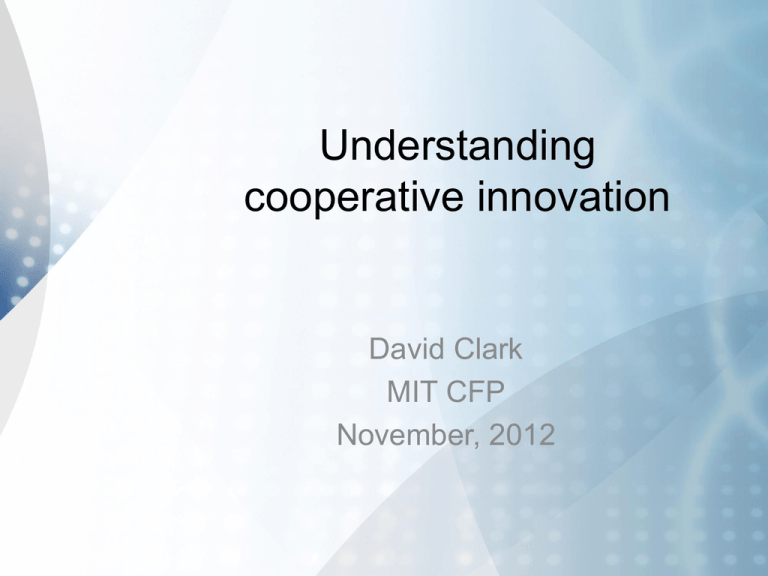Understanding cooperative innovation David Clark MIT CFP
advertisement

Understanding cooperative innovation David Clark MIT CFP November, 2012 The limits of disruption • Small companies do not usually change the world. • Usually, small companies must take the world as they find it, identify a niche, and move in. – Of course, there are exceptions—the true success stories. • Google, Facebook (perhaps), Twitter (perhaps) – And then they are no longer new entrants. They become the new incumbents. How do big firms innovate? • One answer: buy small firms. – Let them take the risk, and buy the successful ones. – But this only gets you “small company” innovation. • Not enough if you dominate the market. – If you own the pie, to grow you have to make the pie bigger. – This means change the world. • Cisco’s Chambers, several years ago, said we can no longer grow by M&A. Making new opportunities • Sometimes one firm can shift the landscape. – Hypothesis: this is not often true. • Multiple actors must align to create new business opportunities (and new social value). • We are calling this cooperative innovation. – Cooperation among competitors and along the value chain to produce new functionality, new capabilities, new opportunities. Observations and examples • Example – The creation of the secure Web (SSL) • Required modification of client and server software, creation of CA system and merchant certificates, the upgrading of many Web servers, and so on. • Created e-commerce. • Observation – The distinction between entrant and incumbent may not be very helpful in understanding the dynamics of cooperative innovation. Consider some failures • • • • Curing spam. QoS on the open Internet. Migration to IPv6. Better security generally. Spam • The rise and fall of Goodmail. – Goodmail proposed a scheme: • Bulk mailers register with their type of service: opt-in, opt-out, spam, etc. • Mail from registered mailers would be forwarded without being filtered, so long as they comply with their service class. • Other bulk mail would be filtered and perhaps modified. • To pay for this, bulk mailers would pay a per-email fee. – Bulk mailers turned on them. • MoveOn, in particular. • Google said the power to filter should be in the hands of the user. – Email providers abandoned them. – They went out of business. Lesson from Goodmail • Large email providers have market power. – The higher-level equivalent of the telco terminating monopoly. • A scheme that additionally empowers actors with such market power will be rejected by the ecosystem. QoS • Tools for QoS do work (technically) but have not been deployed on the public Internet. – No model for charging or allocation of revenues. – No agreement as to what the actual service definition would be. • Continued disagreement as to whether QoS is needed. – Necessity of increased information sharing among competitors was worrying. – Sense that partial deployment would be ineffective in the market. • (We held several meetings to resolve “some of” these issues.) – Now, rejection of the idea in favor of managed services that compete. Lessons from QoS • Disagreement about the value of an idea will almost certainly kill it. • Necessity for a lot of actors to move together is a formidable barrier. – No way to do a “proof of concept” to resolve first issue. • Difficulty of negotiation with competitors is a killer. – Business, technical, legal • Failure of designers to deal with “money routing” is a killer. – Need to propose a business model, not just a technical model. IPv6 • Perhaps not an innovation, just a necessity. • Slow progress. Very slow. • Many ISPs, most OS and service platforms are capable. • Next barrier is upgrading all the Web servers. – Perhaps 200M of them? • Less than 1% upgraded so far. Lessons • Lots of web servers upgraded to SSL, but very few upgrade to IPv6. – Not surprising at all. SSL brings them benefit. – IPv6 is a classic example of an externality. • I expend, somebody else benefits. – Too many actors to come up with an easy scheme to internalize the externality. • At least, I have not seen the scheme yet. • ISPs could charge a premium to services that are not IPv6-ready, if they themselves had the incentive… Generalities • Need a leader. – Should not be the actor with market power. – Need to hunt for the right actor who is in the right position. • Need a financial model. – Need to argue that all actors have some incentive to act. – Shifting revenues along the value chain to balance incentives may not be practical. • Massive transaction costs. • Need balance of power and control along the value chain. • Need an approach that allows incremental deployment and proof of concept. Next • We want to identify other case studies and try to elaborate and better understand general lessons. • Can we solicit examples from you, either historical or forward-looking?





